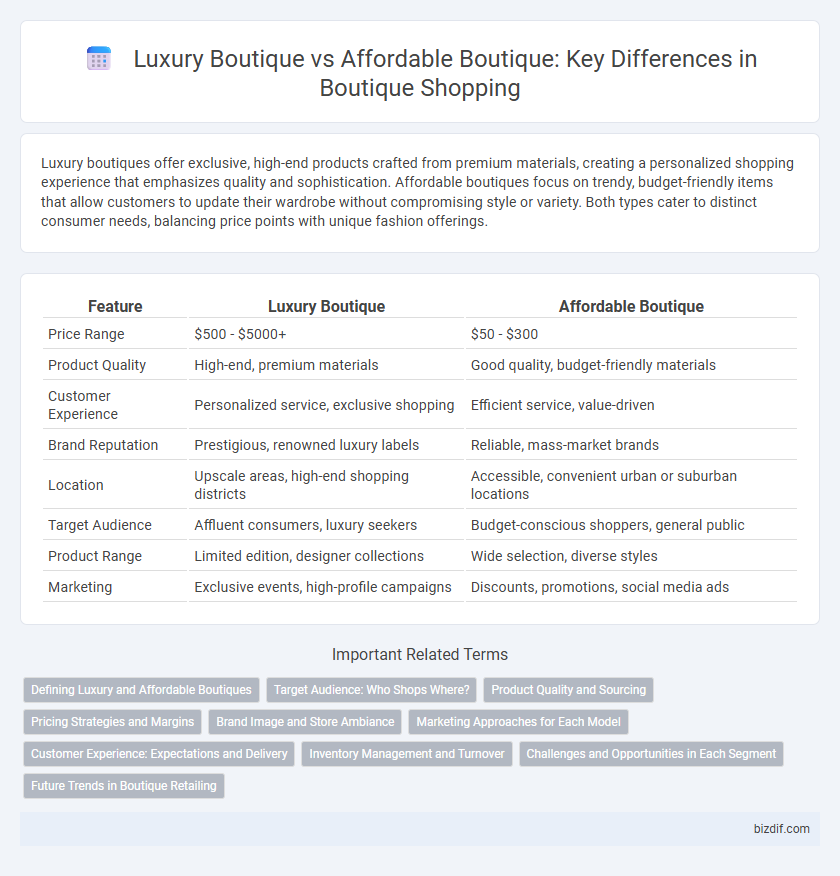Luxury boutiques offer exclusive, high-end products crafted from premium materials, creating a personalized shopping experience that emphasizes quality and sophistication. Affordable boutiques focus on trendy, budget-friendly items that allow customers to update their wardrobe without compromising style or variety. Both types cater to distinct consumer needs, balancing price points with unique fashion offerings.
Table of Comparison
| Feature | Luxury Boutique | Affordable Boutique |
|---|---|---|
| Price Range | $500 - $5000+ | $50 - $300 |
| Product Quality | High-end, premium materials | Good quality, budget-friendly materials |
| Customer Experience | Personalized service, exclusive shopping | Efficient service, value-driven |
| Brand Reputation | Prestigious, renowned luxury labels | Reliable, mass-market brands |
| Location | Upscale areas, high-end shopping districts | Accessible, convenient urban or suburban locations |
| Target Audience | Affluent consumers, luxury seekers | Budget-conscious shoppers, general public |
| Product Range | Limited edition, designer collections | Wide selection, diverse styles |
| Marketing | Exclusive events, high-profile campaigns | Discounts, promotions, social media ads |
Defining Luxury and Affordable Boutiques
Luxury boutiques offer exclusive, high-end products featuring premium materials, designer labels, and exceptional craftsmanship, catering to affluent clientele seeking unique and prestigious items. Affordable boutiques prioritize accessibility, providing trendy, budget-friendly fashion and accessories with a focus on variety and value for price-conscious consumers. The defining distinction lies in product quality, brand prestige, pricing strategy, and target customer experience.
Target Audience: Who Shops Where?
Luxury boutiques primarily attract affluent shoppers seeking exclusive, high-end designer labels and personalized services, catering to individuals prioritizing quality, status, and unique products. Affordable boutiques appeal to budget-conscious consumers looking for trendy, stylish items at reasonable prices, often targeting younger demographics or those valuing cost-effectiveness without compromising fashion. Understanding these distinct target audiences allows boutiques to tailor their marketing and inventory strategies effectively to meet specific customer expectations.
Product Quality and Sourcing
Luxury boutiques prioritize exceptional product quality through meticulous sourcing of rare, high-end materials and collaboration with renowned designers, ensuring exclusivity and craftsmanship. Affordable boutiques focus on sourcing cost-effective materials and streamline production processes to offer trendy, budget-friendly options without compromising basic quality standards. The difference in product quality largely stems from the sourcing strategies, with luxury boutiques investing in premium suppliers and affordable boutiques balancing quality with affordability.
Pricing Strategies and Margins
Luxury boutiques implement premium pricing strategies that emphasize exclusivity, high-quality materials, and brand prestige, resulting in higher profit margins per product. Affordable boutiques adopt competitive pricing to attract cost-conscious consumers, optimizing sales volume to compensate for lower margins. Both models require tailored inventory management and marketing approaches to maximize profitability within their target segments.
Brand Image and Store Ambiance
Luxury boutiques cultivate an exclusive brand image through high-end designer labels and meticulous store ambiance featuring elegant decor, soft lighting, and personalized service. Affordable boutiques emphasize accessibility and value, creating a welcoming atmosphere with vibrant displays and casual layouts to attract budget-conscious shoppers. Both approaches strategically craft their environments to strengthen brand identity and enhance customer experiences.
Marketing Approaches for Each Model
Luxury boutiques leverage exclusivity and high-end branding through personalized marketing, emphasizing craftsmanship and limited editions to attract affluent clients. Affordable boutiques focus on value-driven campaigns, utilizing social media promotions, discounts, and broad accessibility to appeal to budget-conscious customers. Tailoring marketing strategies to these distinct consumer segments enhances engagement and drives sales for each boutique model.
Customer Experience: Expectations and Delivery
Luxury boutiques prioritize personalized customer experience by offering exclusive services, high-end product quality, and an immersive shopping environment tailored to individual preferences, ensuring an exceptional sense of exclusivity and prestige. Affordable boutiques focus on accessibility and value, delivering a friendly, efficient service that meets customer expectations for quality and style at lower price points without compromising on service quality. The key difference lies in luxury boutiques emphasizing bespoke experiences and craftsmanship, while affordable boutiques optimize convenience and cost-effectiveness to satisfy broader customer needs.
Inventory Management and Turnover
Luxury boutiques typically maintain a curated inventory with high-value, exclusive products, resulting in lower turnover rates but higher profit margins per item. Affordable boutiques prioritize a broader product range and faster inventory turnover to attract price-sensitive customers and adapt quickly to market trends. Efficient inventory management systems are critical for both types to balance stock levels, minimize holding costs, and maximize sales performance.
Challenges and Opportunities in Each Segment
Luxury boutiques face challenges such as high operational costs and limited target markets but benefit from opportunities like brand exclusivity and premium pricing strategies. Affordable boutiques encounter challenges including intense competition and thinner profit margins while leveraging opportunities through broader customer reach and higher sales volume. Both segments must strategically adapt to evolving consumer preferences and digital transformation to sustain growth.
Future Trends in Boutique Retailing
Luxury boutiques are increasingly integrating advanced technologies like augmented reality and personalized AI-driven services to elevate the customer experience, targeting affluent consumers who prioritize exclusivity and customization. Affordable boutiques focus on sustainable sourcing and fast adaptation to trends through agile supply chains, appealing to environmentally-conscious shoppers seeking value without compromising style. Both segments are expected to leverage omnichannel retail strategies, blending online and in-store experiences to meet evolving consumer demands and optimize convenience.
Luxury Boutique vs Affordable Boutique Infographic

 bizdif.com
bizdif.com